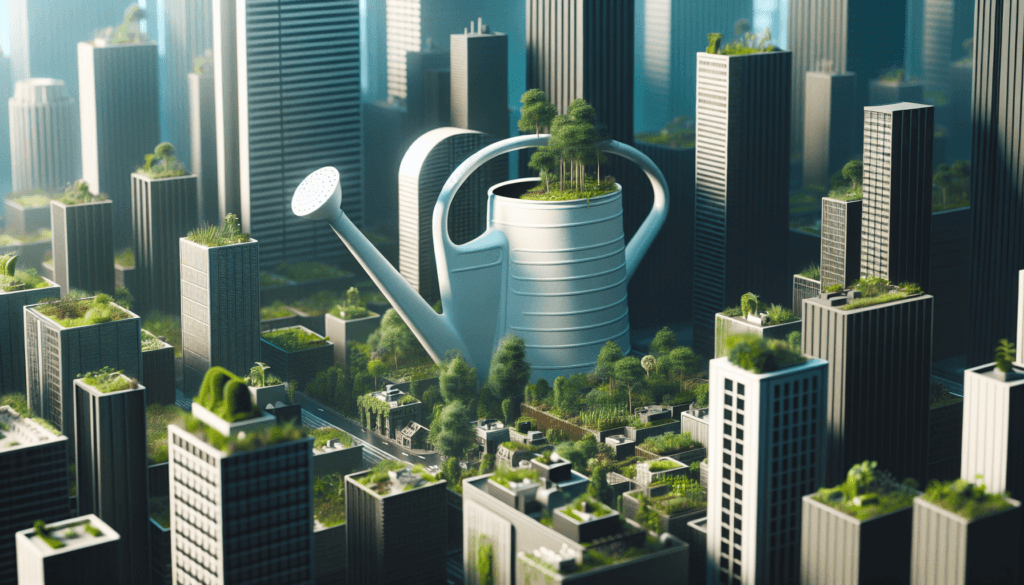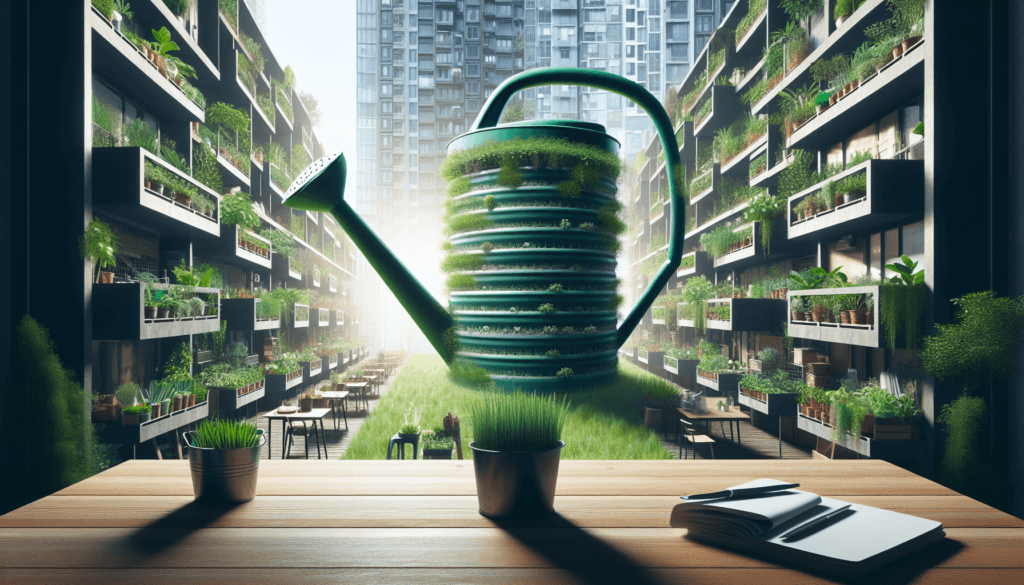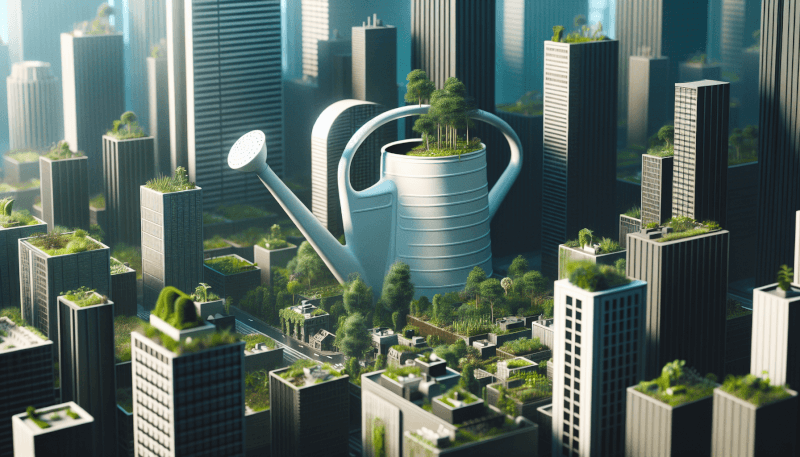Are you tired of your urban garden suffering from lack of proper watering? Look no further! This article explores some innovative watering solutions specifically designed for urban gardens. From self-watering planters to automated irrigation systems, we will cover a range of options that will not only save you time and effort but also ensure healthy growth for your plants. So, if you want to take your gardening game to the next level, keep reading to discover these ingenious solutions for watering your urban oasis.

Irrigation Systems
Drip Irrigation
Drip irrigation is a highly efficient and precise watering system that delivers water directly to the roots of plants. This system uses small pipes with evenly spaced emitters or drippers that release water slowly and steadily. By directly targeting the roots, drip irrigation minimizes water wastage through evaporation and runoff. It is especially beneficial for gardens with limited water availability or for plants that require specific moisture levels. Drip irrigation can be easily automated and is suitable for both small and large-scale urban gardens.
Micro-sprinkler Systems
Micro-sprinkler systems work on the same principle as traditional sprinklers but are designed to release water in much smaller droplets. These systems are ideal for larger garden areas or plantations as they provide uniform coverage and can be adjusted to suit the needs of different plants. The fine mist created by micro-sprinklers also helps to cool the surrounding air, reducing the risk of heat stress for plants during hot summer months. Additionally, micro-sprinkler systems can be combined with smart watering technologies for precise and efficient irrigation management.
Aeroponic Systems
Aeroponic systems are a revolutionary method of growing plants without soil, utilizing a misting system to provide a nutrient-rich solution directly to the plant roots. This innovative technique not only conserves water but also allows plants to efficiently absorb nutrients, resulting in faster growth and higher yields. Aeroponics is particularly suitable for urban gardening, as it can be implemented in small spaces and vertical gardens. By eliminating the need for soil and reducing water usage, aeroponic systems offer a sustainable and space-saving solution for urban gardeners.
Smart Watering Technologies
Weather-based Sensors
Weather-based sensors use advanced technology to monitor environmental conditions such as temperature, humidity, and precipitation. By collecting real-time data, these sensors can adjust watering schedules and amounts based on the specific needs of plants and local weather patterns. This intelligent irrigation management system saves water by preventing overwatering during periods of rainfall or high humidity. Weather-based sensors can be integrated with existing irrigation systems and can be controlled remotely through smart gardening apps.
Soil Moisture Sensors
Soil moisture sensors provide accurate measurements of soil moisture levels, helping gardeners determine when and how much to water their plants. These sensors can be inserted into the ground near plant roots to continuously monitor soil moisture content. When the soil becomes dry, the sensor signals the irrigation system to deliver water only where it is needed. Soil moisture sensors eliminate the guesswork involved in watering and prevent water wastage by ensuring plants receive the right amount of moisture for optimal growth.
Automated Irrigation Controllers
Automated irrigation controllers are smart devices that utilize advanced algorithms and sensors to optimize watering schedules. These controllers can be programmed to consider factors such as plant type, soil type, and sun exposure, ensuring that watering is tailored to the specific needs of each plant. By automating the watering process, these controllers save time, energy, and water. They also provide the freedom to remotely control and monitor irrigation systems through smartphone apps, making them convenient and user-friendly.

Vertical Gardening Techniques
Green Walls
Green walls, also known as living walls or vertical gardens, are innovative vertical structures that support the growth of plants on a vertical surface. These walls consist of modular panels or containers that are mounted onto a wall or framework. The plants are grown in a soil-like substrate or in a hydroponic system, and watered through a drip irrigation or a micro-sprinkler system. Green walls not only add aesthetic value to urban spaces but also provide numerous benefits such as improved air quality, insulation, and noise reduction. They are an excellent solution for maximizing limited space and greening urban environments.
Vertical Hydroponics
Vertical hydroponics is a soil-less gardening technique that allows plants to grow vertically on a vertical structure, such as a tower or wall. In this system, plants are placed in growth media or suspended in nutrient-rich water, which is circulated through the system using a pump. By utilizing a water-efficient nutrient solution, vertical hydroponics maximizes plant growth while minimizing water usage. This technique is particularly suitable for urban gardening as it requires minimal space and can be implemented indoors or outdoors.
Stacked Planters
Stacked planters are a space-saving vertical gardening method that involves stacking multiple layers of planters on top of each other. Each planter layer has openings or pockets for plants, allowing for a vertical arrangement of plants. Water is supplied to the topmost planter and gradually drips down to the lower layers, ensuring that all plants receive water. By utilizing this vertical arrangement, stacked planters optimize space utilization and make it easier to grow a variety of plants in a compact urban setting.
Rainwater Harvesting
Rain Barrels
Rain barrels are simple and cost-effective devices that collect and store rainwater from rooftops or gutters. These containers are typically placed under a downspout, where they capture rainwater runoff. The collected rainwater can then be used for watering plants, reducing reliance on municipal water supplies. Rain barrels come in various sizes and can be equipped with filters to remove debris and prevent mosquito breeding. Using rainwater for irrigation not only saves water but also helps to reduce stormwater runoff and associated pollution, making it an environmentally-friendly watering solution.
Rainwater Collection Systems
Rainwater collection systems are more complex setups that involve the collection, filtration, and storage of rainwater on a larger scale. These systems typically include gutters, downspouts, filters, and storage tanks. Rainwater can be collected from the roof of a building or from a dedicated collection area such as a rain garden or cistern. The collected rainwater can be used for irrigation, as well as for other non-potable purposes such as toilet flushing or laundry. Rainwater collection systems provide a sustainable and cost-effective way to meet water needs in urban gardens.
Green Roofs
Green roofs, also known as living roofs or rooftop gardens, are systems that involve the installation of vegetation on the roof of a building. These roofs consist of a waterproof membrane, drainage layer, growing medium, and plants. Green roofs offer numerous benefits, including stormwater management, improved air quality, and energy efficiency. In terms of watering, green roofs utilize a combination of rainfall and irrigation. Rainwater is absorbed by the vegetation and growing medium, reducing the need for additional watering. Green roofs are an effective way to transform underutilized urban space into green, functional areas while promoting environmental sustainability.

Self-watering Containers
Wicking Beds
Wicking beds are self-watering containers that utilize a capillary action to deliver water directly to plant roots. These beds consist of a water reservoir, a layer of gravel or sand, and a growing medium on top. The water in the reservoir is drawn up through the bed via a wicking material, such as a geotextile fabric or wicking pipe. The plants’ roots take up water as needed, ensuring a constant supply of moisture. Wicking beds are an excellent solution for urban gardens as they minimize water wastage, reduce the frequency of watering, and create a favorable growing environment for plants.
Sub-irrigated Planters
Sub-irrigated planters (SIPs) are self-watering containers that work on the principle of passive hydroponics. These planters consist of a water reservoir, a wicking material, and a growing medium. The water in the reservoir is wicked up to the root zone of the plants, providing them with a steady supply of moisture. Excess water is automatically drained, preventing waterlogging and root rot. SIPs are easy to use, require less frequent watering, and are ideal for urban gardeners with limited time or access to water sources.
Self-watering Pots
Self-watering pots are designed with a built-in water reservoir that delivers water directly to the plant’s roots. These pots have a wicking system that draws water up from the reservoir as needed. The wicking material can be a fabric wick or a porous ceramic cone. Self-watering pots are an excellent choice for urban gardeners who may be away from home frequently or have limited access to water sources. These pots help maintain optimal moisture levels for plants, reducing the risk of underwatering or overwatering.
Greywater Recycling
Greywater Treatment Systems
Greywater treatment systems collect and treat water from sources such as sinks, showers, and washing machines for reuse in irrigation. These systems remove impurities and contaminants from greywater, making it safe for plant irrigation. The treated greywater can be used to irrigate gardens, reducing the reliance on freshwater supplies. Greywater treatment systems are an environmentally-friendly solution that not only saves water but also helps to conserve energy and reduce the strain on wastewater treatment facilities.
Greywater Irrigation
Greywater irrigation involves using untreated greywater directly for watering plants. This can be done by diverting greywater from sources such as showers or sinks to the garden or by manually carrying greywater to the plants. Greywater typically contains lower levels of contaminants compared to blackwater (from toilets), making it suitable for irrigation. However, it is important to consider certain guidelines and precautions to ensure safe and effective greywater use. Greywater irrigation is a sustainable practice that promotes water conservation and supports healthy plant growth.
Greywater Diversion
Greywater diversion systems capture greywater from sources such as showers, bathtubs, and laundry sinks and divert it to an irrigation system or storage tank. These systems separate greywater from blackwater (toilet waste) to prevent contamination and allow for safe and efficient reuse. Greywater diversion systems are relatively easy to install and provide a cost-effective way to reduce water consumption in urban gardens. By diverting and reusing greywater, gardeners can significantly reduce their reliance on freshwater supplies and contribute to a greener and more sustainable environment.

Solar-powered Watering
Solar-powered Drip Irrigation
Solar-powered drip irrigation systems utilize energy from the sun to power the irrigation process. These systems consist of solar panels that convert sunlight into electricity, which is then used to power the irrigation pumps or controllers. By harnessing renewable energy, solar-powered drip irrigation reduces reliance on traditional electricity sources and helps to minimize carbon emissions. This eco-friendly solution is particularly beneficial for off-grid or remote urban gardens where access to electricity may be limited.
Solar-powered Sprinkler Systems
Solar-powered sprinkler systems operate on the same principle as solar-powered drip irrigation but are designed to deliver water through sprinklers. These systems use solar panels to generate electricity, which powers the sprinklers and other components. Solar-powered sprinkler systems are a sustainable and cost-effective alternative to traditional irrigation systems that rely on electricity or fossil fuels. They are particularly useful for large urban gardens or agricultural areas where extensive coverage is required.
Solar-powered Fountain Pumps
Solar-powered fountain pumps provide a sustainable solution for creating beautiful water features in urban gardens. These pumps use solar panels to convert sunlight into electricity, which powers the pump that circulates the water. Solar-powered fountain pumps are energy-efficient and eco-friendly, eliminating the need for expensive electricity or batteries. They can be used to create stunning water displays, provide aeration for ponds or water gardens, and attract beneficial wildlife. Solar-powered fountain pumps offer an environmentally-conscious way to enhance the aesthetics and biodiversity of urban garden spaces.
Aquaponics Systems
Hydroponics and Fish Farming
Aquaponics is a sustainable and integrated system that combines hydroponics (growing plants in water) with fish farming. In aquaponics systems, fish waste serves as a nutrient source for the plants, while the plants filter and purify the water for the fish. This mutually beneficial relationship creates a closed-loop system where water and nutrients are continually recycled. Aquaponics is highly efficient, with water savings of up to 90% compared to traditional soil-based agriculture. It also allows for higher crop yields and reduces the need for chemical fertilizers. Aquaponics systems are ideal for urban gardeners looking for a space-saving and resource-efficient way to grow both plants and fish.
Nitrogen Cycle
The nitrogen cycle is a crucial process in aquaponics that ensures the availability of essential nutrients for plant growth. In this cycle, fish excrete waste that contains high levels of ammonia. Bacteria in the aquaponics system convert this ammonia into nitrite and then into nitrate, which is the form of nitrogen that plants can absorb and utilize. The plants uptake the nitrate, removing it from the water, and in doing so, help to maintain water quality for the fish. The nitrogen cycle in aquaponics demonstrates the interdependent relationship between plants and fish, creating a closed-loop ecosystem with sustainable benefits.
Biofilter Conversion
Biofilter conversion is a key component of aquaponics systems that helps to maintain water quality and balance the nitrogen cycle. In biofilter conversion, beneficial bacteria are cultivated in a specialized filter medium, such as gravel or expanded clay pellets. These bacteria convert toxic ammonia into nitrite and then into nitrate, completing the nitrogen cycle and providing essential nutrients for plant growth. The biofilter acts as a natural filtration system, ensuring the water remains clean and suitable for fish and plants. Biofilter conversion is an essential process in maintaining the health and productivity of aquaponics systems.

Cloud-based Gardening Apps
Plant Watering Reminders
Cloud-based gardening apps offer a convenient way to manage watering schedules for urban gardens. These apps provide personalized plant watering reminders based on factors such as plant type, local weather conditions, and soil moisture levels. By tracking and analyzing data, the apps send notifications and reminders to ensure plants receive the right amount of water at the right time. Plant watering reminders help to prevent under or overwatering, promoting healthier plant growth and conserving water resources.
Real-time Monitoring
Cloud-based gardening apps allow for real-time monitoring of urban gardens, providing valuable insights into factors such as soil moisture levels, temperature, humidity, and light intensity. By collecting and analyzing data from sensors and weather forecasts, these apps offer a comprehensive view of the garden’s conditions. Real-time monitoring enables gardeners to make informed decisions regarding watering, pest control, and plant care. It also facilitates remote control and adjustments of irrigation systems for optimal efficiency and water conservation.
Gardening Tips
Cloud-based gardening apps provide a wealth of gardening tips, advice, and resources to empower urban gardeners. These apps offer information on plant care, watering techniques, pest management, and other aspects of gardening. Whether you’re a beginner or a seasoned gardener, the apps provide valuable insights and expertise to help you optimize your urban garden. Gardening tips in the apps are tailored to specific plant types, local climate conditions, and gardening goals, ensuring the best possible outcomes for your urban gardening endeavors.
Mulching Techniques
Organic Mulch
Organic mulch is a natural and sustainable way to conserve soil moisture and suppress weed growth in urban gardens. This type of mulch is made from organic materials such as straw, wood chips, leaves, or grass clippings. Organic mulch helps to retain soil moisture by reducing evaporation and regulating soil temperature. It also acts as a barrier to weed growth, preventing competition for water and nutrients. Organic mulch breaks down over time, enriching the soil with nutrients and improving its structure. By using organic mulch, urban gardeners can significantly reduce water usage and promote healthy plant growth.
Plastic Mulch
Plastic mulch is an effective solution for conserving soil moisture and preventing weed growth in urban gardens. This type of mulch is made from black or colored plastic film that is spread over the soil surface. Plastic mulch creates a barrier that reduces evaporation and helps to maintain soil moisture levels. It also blocks sunlight, preventing weed seeds from germinating and competing with plants for water and nutrients. Plastic mulch is particularly useful in areas with low rainfall or high temperatures, as it provides additional protection against water loss and helps to regulate soil temperature.
Gravel Mulch
Gravel mulch, also known as inorganic mulch, is a low-maintenance and long-lasting option for urban gardens. This type of mulch consists of small rocks or gravel that are spread over the soil surface. Gravel mulch helps to reduce evaporation by acting as a protective layer, preventing direct contact between the soil and the air. It also improves water drainage and prevents soil erosion. Gravel mulch is an ideal choice for drought-tolerant plants or areas prone to heavy rainfall. It requires minimal maintenance and provides a clean and distinctive aesthetic to urban garden spaces.
Innovative Watering Solutions for Urban Gardens provide a wide range of options to meet the unique needs and challenges of urban gardening. From efficient irrigation systems like drip irrigation and micro-sprinkler systems to advanced technologies like smart watering systems and cloud-based gardening apps, urban gardeners have an array of tools and techniques at their disposal. Vertical gardening techniques, such as green walls, vertical hydroponics, and stacked planters, allow for maximizing space utilization and greening urban environments.
Rainwater harvesting through rain barrels, rainwater collection systems, and green roofs offers a sustainable solution to reduce reliance on municipal water supplies and minimize water wastage. Self-watering containers, including wicking beds, sub-irrigated planters, and self-watering pots, provide convenience and water efficiency for busy urban gardeners.
Greywater recycling systems such as greywater treatment systems, greywater irrigation, and greywater diversion enable the reuse of water from sinks, showers, and washing machines, promoting water conservation and reducing strain on freshwater supplies. Solar-powered watering systems, including solar-powered drip irrigation, solar-powered sprinkler systems, and solar-powered fountain pumps, harness renewable energy to power irrigation processes, offering environmentally-friendly alternatives.
Aquaponics systems combine hydroponics with fish farming, creating a symbiotic relationship that maximizes water and nutrient utilization, while cloud-based gardening apps provide real-time monitoring, plant watering reminders, and gardening tips to optimize urban gardens. Mulching techniques, such as organic mulch, plastic mulch, and gravel mulch, help conserve soil moisture and suppress weed growth.
No matter the size or constraints of an urban garden, there are innovative watering solutions available to promote sustainable and efficient water use. With these technologies and techniques, you can transform your urban garden into a thriving oasis while reducing water waste and promoting environmental sustainability.


